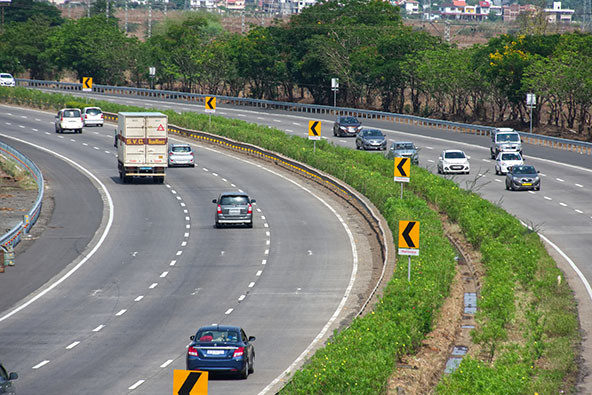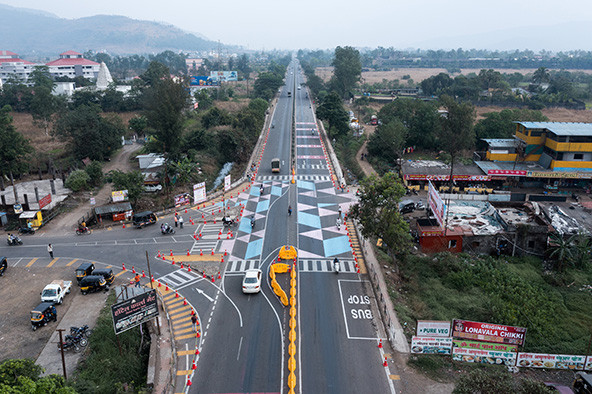 (Photo by iStock/Dinesh Hukmani)
(Photo by iStock/Dinesh Hukmani)
During the early hours of January 30, 2022, an SUV on India’s National Highway 48 jumped over the median and rammed head-on into an approaching truck. The driver had fallen asleep at the wheel and, with no crash barrier to stop the vehicle, all five occupants were killed. Traffic crashes like this one claim more than 1.35 million lives globally each year, but low- and middle-income countries shoulder 93 percent of these deaths (despite being home to only about 60 percent of the world’s vehicles). India alone, with only one percent of the world’s motor vehicles, accounts for 11 percent of global road crash fatalities; in 2020, India reported 3,66,138 road crashes and 1,31,714 fatalities.
Most road crash fatalities, though, are preventable.
What Works
In 2016, SaveLIFE Foundation (SLF), an Indian non-profit organization, introduced the Zero Fatality Corridor (ZFC) solution, which has, since its inception, delivered an unprecedented reduction in road crash fatalities on the stretches of road where it has been deployed. The ZFC solution has adapted and added to the Safe System Approach, traditionally a western concept, to make it suitable for Indian conditions and requirements.
Are you enjoying this article? Read more like this, plus SSIR's full archive of content, when you subscribe.
The Safe System Approach recognizes that people are fallible and can make mistakes that may be fatal for them or their fellow road-users—irrespective of how well they are trained.
The ZFC model, in turn, is an innovation designed specifically to accommodate the realities, resources, and existing infrastructure in low- and middle-income countries, which are vastly different from their developed counterparts. For example, unlike developed nations, people in low- and middle-income countries often live closer to the highways, and use them on a daily basis on foot or through traditional and slower modes of transportation. This gives rise to high crash conflict areas.
Some of the practices that are a part of the ZFC solution include optimized placement of ambulances at high-fatality locations, the utilization of drones to identify parked vehicles to preemptively prevent rear-end collisions, and road engineering solutions unique to the realities of countries like India. The ZFC model has helped create a secure environment specific to such countries with safer roads, safer vehicles, safer speeds, safer drivers, and rapid post-crash response.
The ZFC model was first deployed in 2016 on the Mumbai-Pune Expressway (MPEW) in Maharashtra, through a collaboration between SLF, Maharashtra State Road Development Corporation (MSRDC), and automaker Mahindra & Mahindra. From 2010 to 2016, the 95-kilometer stretch witnessed 2,579 crashes and 887 fatalities, making it one of India’s deadliest roads.
 Intersections on India’s National Highways are being made safer using the Zero Fatality Corridor (ZFC) model. (Photo courtesy of the SaveLIFE Foundation)
Intersections on India’s National Highways are being made safer using the Zero Fatality Corridor (ZFC) model. (Photo courtesy of the SaveLIFE Foundation)
As part of the ZFC solution, over 800 crashes were scientifically investigated to uncover the infrastructural, vehicular, and human factors: infrastructural hazards such as exposed concrete structures, behavioral issues such as drivers using the shoulder to overtake, and vehicular problems such as missing safety gear. For example, SLF identified over 3,500 separate engineering issues, and receptive partners at MSRDC ensured that the majority of these issues were fixed expeditiously: guarding concrete structures on the expressway with crash barriers, installing signage to help regulate driver behavior, and closing unplanned gaps in the median to prevent sudden high-speed collisions.
The data also revealed an urgent need to prevent rear-end collisions, as they contributed to nearly 40 percent of all deaths on the expressway. In many cases, sleepy drivers hit parked or stalled vehicles on the shoulder. The existing guidance (from the West) was to prevent such crashes by installing “tactile edge lines,” a treatment that would create a loud sound in the vehicle cabin if the driver crossed the line. Unfortunately, this was found to be ineffective in Indian conditions: some drivers would simply drive over the narrow edge lines to reach the shoulder lane and use it for overtaking. To discourage this, the tactile edge lines were broadened and spread across the entire breadth of the shoulder. This alteration, named by SLF as “tactile shoulder lines” (TSL) had an immediate positive impact.
Another action to prevent rear-end collisions was to use active traffic enforcement to disallow casual parking on the expressway. High visibility patrol vehicles and drones were deployed by SLF to preemptively identify parked or broken-down vehicles and remove or barricade them, a system which has now been transferred to the police and road-owning agency. Enforcement capacity of the police was further expanded by deploying speed enforcement cameras, especially within and ahead of high-fatality zones.
To make emergency medical response faster, data analytics was used to identify high-fatality zones; instead of the existing practice of placing an ambulance at toll plazas, relocating ambulances closer to dangerous locations brought the average response time down from 35 minutes to under 10 minutes.
Replication
As of 2020, the ZFC model successfully brought fatal road crashes on the expressway down by 52 percent (when statistically adjusted for the impact of COVID). This has encouraged the Indian federal as well as state governments to adopt the model for other safety-sensitive stretches. For instance, the state government of Maharashtra, in partnership with SLF and Skoda Auto Volkswagen India, added a 111-km segment of National Highway 48 to its list of ZFCs. Proven ZFC interventions across road engineering, police enforcement, trauma care, and community engagement helped bring down road crash deaths on this stretch from 268 in 2018 to 79 in 2020, a 54 percent reduction in deaths (when statistically adjusted for the impact of COVID).
Over the past two years, the program has also delivered a 38 percent reduction in deaths on the “Yamuna Expressway” in Uttar Pradesh, India’s most populous state and the one that shoulders the country’s highest road crash fatality burden.
Scaling Nationally and Globally
As a result of the model’s success, India’s Ministry of Road Transport and Highways (MoRTH) has partnered with the SaveLIFE Foundation to scale this model to the top 15 most dangerous highways in the country. This includes a highway each in Uttar Pradesh, Maharashtra, Karnataka, Tamil Nadu, Telangana, Haryana, Madhya Pradesh, Punjab, Gujarat, Bihar, Chhattisgarh, Andhra Pradesh, Rajasthan, and West Bengal.
The ZFC model looks at conditions and realities specific to low- and middle-income countries and makes scientifically-backed suggestions on the most cost-effective solutions for road crash and fatality prevention. The model is adjustable and scalable for contexts where complex settings and low resources are the major deterrents to employing the traditional road safety guidance emerging from developed nations.
Safe roads are a prerequisite to various rights within the Universal Declaration of Human Rights, including the rights to life, education, freedom of movement, and employment, among others. Road safety is also specifically called out in not one but two UN Sustainable Development Goals, 3.6 and 11.2. The ZFC model’s evidence-based, 360-degree, distilled set of solutions, and ease of implementation, make it a prime candidate for replication in India and beyond.
Support SSIR’s coverage of cross-sector solutions to global challenges.
Help us further the reach of innovative ideas. Donate today.
Read more stories by Krishen Mehta & Piyush Tewari.

